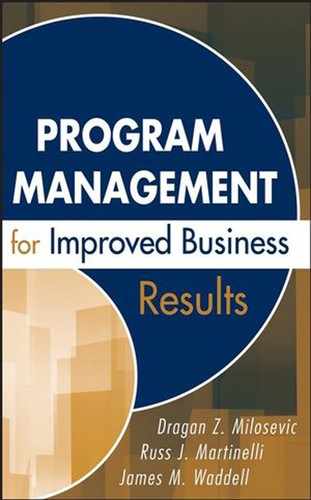Part II explained how program managers navigate programs through the phases of the PLC with the use of proven practices and processes. Even though these practices and processes are revealing, they don't constitute the whole picture for one reason: They don't include program management tools and performance measures that help to implement the practices and processes. Part III explains how performance measures and tools enable the effective execution of program management practices and processes.
In Chapter 9, we will shed light on performance measures that we term metrics for program management. Their intent is to focus attention on the business results of the organization and serve as the critical success factors in programs and projects. Given both their strategic and tactical nature, we emphasize the need to carefully engineer and install metrics. This means that they are compatible (or mutually aligned), balanced, consistently implemented, and tiered.
To help visualize a system of metrics and how they are tiered, we offer the Program Management Value Pyramid, which includes the following four levels:
Strategic management metrics
Program portfolio management metrics
Program management metrics
Project management and team execution metrics
The pyramid helps integrate the four levels and guide business improvement efforts. We stress the point that each company should develop a menu of metrics that respond to its own specific situation. Metrics also need to support the company's business strategy.
Chapter 10 specifies five management tools that complement one another in implementing the strategic planning process. These tools enable program managers to fathom the nature and position of their programs in relation to all current and future programs and to the companies, business strategies. Each of the five tools has a clear-cut aim. The program business case defines the program, tests the feasibility of the program against the business objectives and operating environment, and sets the program success criteria. On that basis, a program is checked for alignment with the business strategy by means of the program alignment matrix and, if aligned, is added to the portfolio of programs. There, the program portfolio map is put to work in evaluating, prioritizing, and balancing the portfolio of programs from multiple strategic criteria identified by the executive team of the organization. The program road map indicates the timeline and dependencies of programs in the portfolio as they exist in the company's development pipeline. The program complexity assessment helps determine the skill level that is required of the program manager and PCT to run a program.
For the tactical process of program planning and execution, tools are also needed—we call them operational program-management tools. In Chapter 11, we present 5 of these complementary tools. The aim of these tools is to allow the program manager to effectively plan, monitor, report, and control progress of individual programs. He or she uses the program strike zone to identify the program's critical success factors and develops the program map to find the critical cross-project dependencies that need to be coordinated. The program manager also uses the P-I matrix to find and focus on the program areas of highest risk. When the program execution unfolds, the program review is applied to check phase gates and other major program events. Throughout execution, the program dashboard helps report program status. It is recommended that program managers use the strategic and tactical tools as a tool set, although each may be employed individually.
An example that covers both metrics and tools is provided at the end of this section. It demonstrates how a high-technology organization aligns metrics and tools use with its business strategy.
